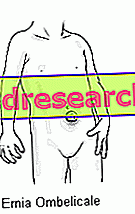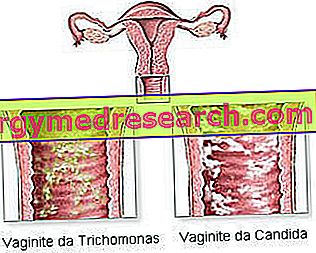Key points
The umbilical hernia is a protrusion of the abdominal lining - or of a part of an abdominal organ - through the navel. This is a particularly frequent condition in infants and young children, particularly of African ethnicity; adults and the elderly can also be affected.

Classification
There are more variants of umbilical hernia:
- EMBRYON ERNIA: often incompatible with the life of the unborn child
- FETAL ERNIA: appears after the third month of gestational life
- CHILD ERNIA OR NEONATAL: the most common of all. It tends to resolve spontaneously in a few months
- OMBELIC HERNIA OF ADULT: requires specific surgical intervention
Causes
- In the child, the umbilical hernia is almost always congenital and depends on a defect of closure of the abdominal wall after the fall of the umbilical cord. Rarely, herniation depends on severe secondary diseases (eg collagen pathologies).
- In adults, umbilical hernia depends on the increase in intra-abdominal pressure, in turn caused by cirrhosis, ascites, multiple pregnancies, tumors, obesity.
Symptoms
The umbilical hernia causes pain, swelling and circumscribed burning. The pain is accentuated with a cough or a sneeze. Complications → in the adult, an untreated umbilical hernia can degenerate into an incarcerated hernia or strangled hernia.
therapies
Infant umbilical hernias regress spontaneously within 12-18 months of life. In adults, umbilical hernia requires surgery
What is umbilical hernia?
An "umbilical" is an abdominal hernia that develops at the umbilical scar.

Umbilical hernia is a generally harmless clinical condition, and is quite common in children; what has been said, however, does not exclude the possibility that adults and the elderly will be affected. In adults, it is estimated that the umbilical hernia represents 6% of all abdominal hernias: the disorder occurs particularly in women between the ages of 35 and 60 years. Umbilical hernia is extremely common in individuals of African ethnicity.
In newborns and older children, umbilical hernia tends to resolve spontaneously over a few months; otherwise, in adults this form of abdominal hernia almost always requires specific surgical intervention.
Classification based on age
There are several types of umbilical hernia, differentiated according to the age of onset:
- EMBRYONIC ERNIA: it is the result of an arrest of the development of the abdominal wall during the embryonic age. The embryonic umbilical hernia is an extremely dangerous form, so much so that it often proves incompatible with the life of the unborn child due to the associated malformations. It is almost impossible to surgically reconstruct the abdominal neoparet of the embryo.
- FETAL HERNIA: in order to be called "fetal", the umbilical hernia must appear after the third month of intrauterine life, or when the peritoneal cavity is already regularly developed. Even the umbilical ring is already established, although it has remained very large. In this case, the fetus can be operated on surgically.
- CHILD ERNY OR NEONATAL: is the most common form of umbilical hernia, which occurs in the period between the fall of the umbilical stump and the 6th month of life (in most cases). The neonatal hernia is due to a defect of closure of the abdominal wall after the fall of the umbilical cord. In general, surgery is not necessary: the hernia tends to regress spontaneously, resolving itself over a period of 6-12 months.
- OMBELIC HERNIA OF ADULT: typical hernia of "weakness", in the adult it is generally due to loss of tone of the abdominal muscles. In the vast majority of cases, this form of herniation requires surgery.
To fix the concepts ...
Umbilical hernia in children and adults
Unlike that of the adult, the umbilical hernia of the child tends to resolve spontaneously without the need for medical intervention. The above is explained by the underlying cause: in the child, the umbilical hernia generally has a congenital origin and manifests itself during the first months of life, while in the adult the problem is due to an acquired weakness of the abdominal wall.
Classification by size
A further classification of umbilical hernias is performed according to the size of the hernial collar:
- Small umbilical hernia: the diameter is less than 2 cm
- Medium-sized umbilical hernia: the diameter measures 2-4 cm
- Large umbilical hernia: the diameter exceeds 4 cm


In the small CHILD, the umbilical hernia is caused by a defect in closing the abdominal wall after the fall of the umbilical cord. Let us briefly recall that during gestation the umbilical cord passes through a small opening located in the abdominal muscles of the fetus. This orifice closes only after birth: later, if the muscles do not perfectly join the midline of the abdomen, it is possible that the child manifests a hernia, soon reversible.
Only rarely does the umbilical hernia in the child have large dimensions: in similar situations, it is possible to suspect that the disorder is related to serious secondary pathologies, such as:
- Disorders of collagen and polysaccharide metabolism:
- Hunter-Hurler syndrome, characterized by disharmonic dwarfism, alteration of skin and cornea, psychic delay;
- imperfect osteogenesis: genetic anomaly in which the affected patient, due to a serious anomaly in the synthesis of collagen, presents serious alterations affecting joints, spine, ears, skin and teeth;
- Ehlers-Danlos syndrome: the patient suffering from this genetic disease has hyperplasticity of the skin and ligament laxity. The disease affects connective tissue due to a collagen mutation;
- Congenital hypothyroidism;
- Down syndrome;
- Freeman-Sheldon syndrome (or blowing face syndrome): it is a rare congenital disorder characterized by anomalies of the spine and face;
- Fetal idantoin syndrome (idantoin is a drug used to treat epilepsy).
In ADULT, on the other hand, umbilical hernia is a less frequent phenomenon, although more problematic, since it requires specific surgical intervention. In similar circumstances, umbilical hernia is the result of the increase in intra-abdominal pressure, in turn caused by:
- Ascites (accumulation of fluid in the abdominal cavity)
- Cirrhosis
- Pregnancies (especially multiple)
- Obesity / overweight
- Extreme stress (heavy lifting)
- Past history of abdominal surgery
- Tumor in the abdominal cavity
- Flabby belly
Genetic predisposition also plays a major role in the manifestation of umbilical hernia in adults.
Umbilical hernia - Symptoms and Therapy »



